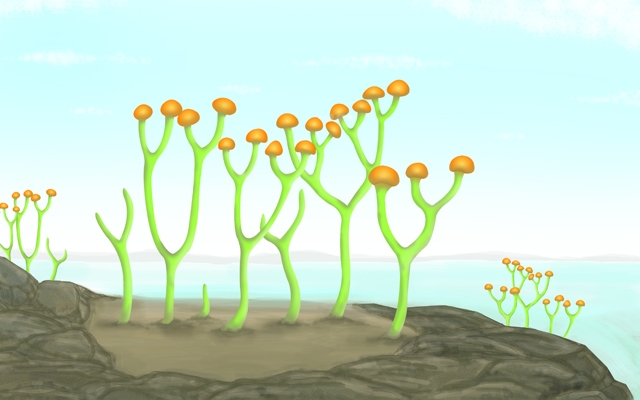
クックソニア
Cooksonia

石炭紀の大森林
Carboniferous giant forest
動物と同様に植物も古生代を通して大きく進化をとげた。ここでは植物の進化の歴史を覗いてみよう。
陸上植物はカンブリア紀に淡水(淡水とは塩分を含まない水)に生息していた緑藻類、特に車軸藻に近い藻類から進化したと考えられている。現在までに見つかっている陸上植物の証拠となる最古の化石は、オマーンから発見されたオルドビス紀の胞子の化石である。
海から上陸をはたした植物が陸地のさらに奥深くへと進出するためには、乾燥や重力に耐えられる強い体を手に入れなければならなかった。その鍵はリグニンと呼ばれる物質にある。リグニンは細胞の表面から水分が蒸発するのを防ぎ、さらに細胞壁を強化することで大きな体を維持することを可能にする。シルル紀になると陸上植物はリグニンを形成することに成功して、大きく多様化をとげたのである。植物の維管束は水や栄養分を運ぶだけではなく巨大化するのに役立つが、その維管束を初めて持った植物の出現もおそらくは同じ頃であたと推定される。なお、シルル紀のクックソニアは維管束植物ではないが、陸上植物の容姿を確認することができる最古の化石として大変貴重である。
デボン紀になると陸上植物はさらに木部を発達させ、葉や根、タネも発明した。種子植物の出現である。さらに次の石炭紀には巨大化したシダ植物によって大森林が形成された。ちなみに、現在、我々が工業資源として用いる石炭の多くは、この石炭紀の木が埋没したものである。
ところで、石炭紀に大森林を形成した陸上植物は、光合成によって大気中の酸素を急激に増やし、二酸化炭素を減少させた(☞5ページ)。その結果、大気の酸素濃度は現在の21%より1.5倍も高い35%にまで上昇したらしい。高い大気の酸素濃度は巨大な節足動物の出現をまねいた。例えば、体長が75cm程の原始的なトンボのメガネウラや、さらには体長2〜3mもある原始的なヤスデのアースロプレウラ(☞3ページ)が出現したというから驚きである。
Just like animals, plants also evolved greatly through the Paleozoic era. Let's look into plants' evolution history.
It is believed that land plants have evolved from green algae and especially from an alga close to the freshwater (freshwater is a salt free water) Characeae in Cambrian. The oldest evidence of land plants in the fossil record has been discovered in Oman through Ordovician fossilized spores.
In order for the former aquatic plants to go more and more deeper into the land, they had to strengthen their body so they can withstand drying and gravity. One of the keys of the success of land plant is a substance called lignin. Lignin prevents cell surface from moisture evaporation and helps the body growth by strengthening cells walls. When land plants successfully managed to create lignin during the Silurian, they started to greatly diversify. Plants’ vascular bundle is not only useful for carrying water and nutrients but also for growth. Leading scientists to presume that vascular bundle emerged probably at the same time than lignin. Although the Silurian Cooksonia was not a vascular plant, it is a very valuable fossil as it is the oldest fossil evidence that confirmed the appearance of land plants.
During the Devonian, land plants further evolved into trees and developed leaves, roots and seeds. It is the emergence of the Spermatophyte (seed plant). In the next era called Carboniferous, giant fern plants constituted large forests. By the way, most of the coal (fossil energy) currently used as an industrial resource, is the result of buried tree fossils.
By the way, terrestrial plants that formed the Carboniferous large forests suddenly increased the oxygen in the atmosphere by photosynthesis, and reduced carbon dioxide (☞ page 5). As a result, it seems that the oxygen concentration in the atmosphere has risen to 35%, which is comparatively 1.5 times higher than the current 21% level. This high concentration of oxygen in the atmosphere led to the emergence of huge arthropods. For example, a 75cm primitive dragonfly called Meganeura or a 2 to 3 meter long primitive millipede called Arthropleura (☞ Page 3) appeared.